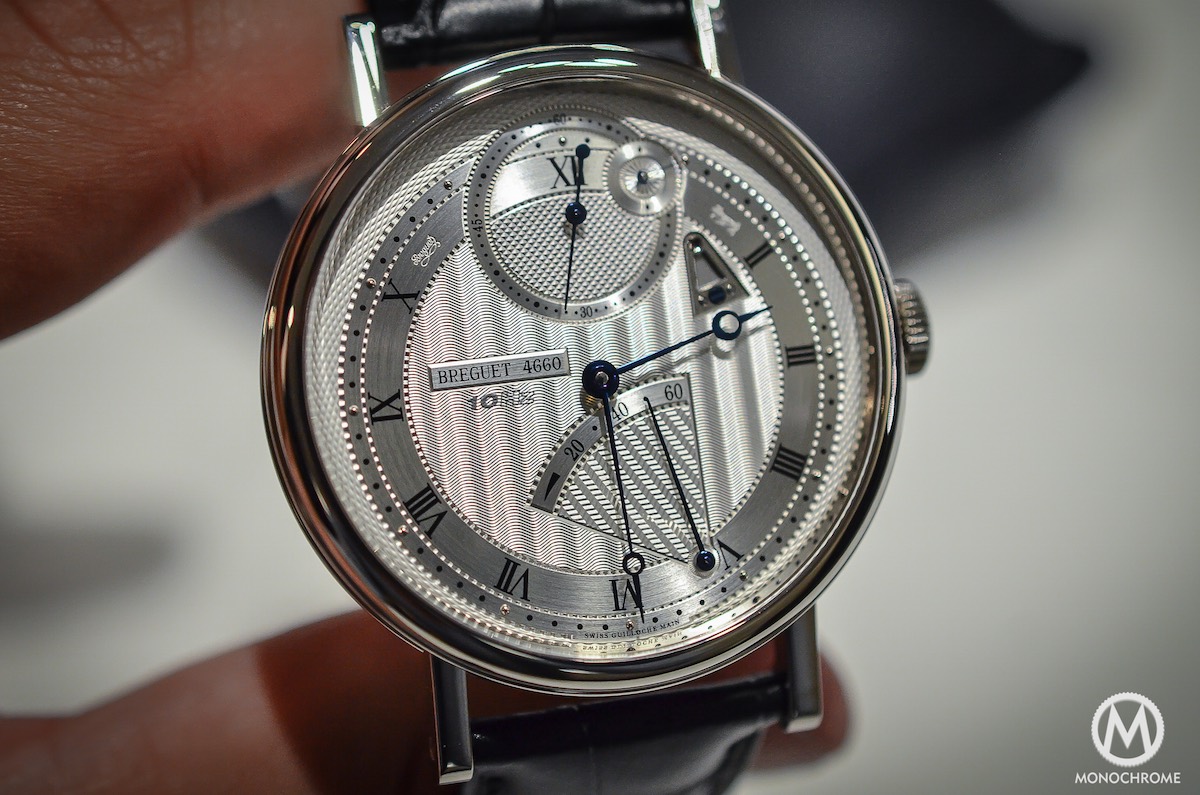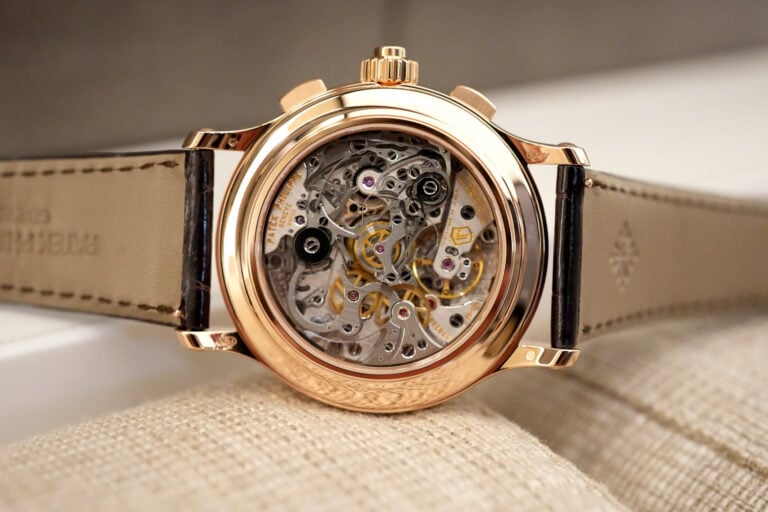Breguet Classique Chronométrie 7727 – detailed Hands-on (live photos, specs and price)
Here is the winner of the Grand Prix d’Horlogerie de Genève, the prestigious contest that awards each year the best watches made by the industry. This edition of the GPHG was truly interesting and so is the winner. The Breguet Classique Chronométrie 7727 does really deserve its title of Watch of the Year or ‘Aiguille d’Or‘. This is not only due to the superb design. What Breguet achieved is more complex and deep than just creating a beautiful watch. They achieved to mix the classical Breguet features to a truly innovative movement that includes new materials, magnetism and high-frequency. An impressive watch detailed here.

Magnetism… Yes, you’ve read correctly. Breguet is using magnetism, watches worst enemy, in a movement. When most of the brand had been trying for years to beat the issue of magnetic fields, such as Rolex with the Milgauss or Omega with its new and impressive Master Co-Axial, Breguet goes one step further. First, the R&D team managed to mastered the negative effects of magnetism in a mechanical watch, but they also managed to use magnetism to improve chronometry. 3 main particularities have to be noticed when talking about the movement featured in the Breguet Classique Chronométrie 7727: silicon – magnetic pivots – 10Hz.

At first glance, as beautiful as can be this new Breguet’s movement, it does not seem to be impressive or innovative. However, the combination of 3 small and almost invisible features creates a spectacular technological progress:
- Silicon: silicon (or silicium in french) has several interesting properties. First, it can be machined with a very high level of precision, in order to create complex pieces such as balance springs, anchors or escapement wheels (in fact, most of the pieces that compose the regulating organ and escapement mechanism of a watch). Then, it is extremely resistant and light (a huge advantage when it comes to high frequencies) and does not need to be lubricated. Finally, it is not affected by magnetic fields. Here is the first part of the work done by Breguet: mastering the magnetism issue by using a balance spring, an anchor and an escapement wheel made of silicon.
- Magnetic pivots: Because the teams of Breguet managed to beat the negative effects of magnetism in the movement, they can now use it to control the movements of the balance wheel. With this patented mechanism, Breguet is the first not to only counteract the effects of magnetism but to use it as a friend of the movement, in order to increase protection, precision and stability over the time. This is how Breguet explains the system: By incorporating a powerful micro-magnet in each of the two endstones supporting the balance pivots, Breguet has designed a dynamically stable system that self-adjusts after a disturbance. The magnetic pivot consists of a carbon-steel balance-staff and a ‘rare-earth’ magnet behind each end-stone. One of the magnets is stronger than the other so that the balance-staff is in permanent contact with the endstone on the dial side and thus appears to be suspended. Thus the balance wheel is kept stable and protected against low-intensity shocks and accelerations. Even after a shock, the balance wheel returns almost instantaneously to its correct position. The other advantage is to reduce frictions and thus lowering their effects on time-keeping. The watch would be more accurate. Finally, because the balance-wheel and balance spring are virtually ‘floating’ and maintained in this ‘artificial gravity’, they are no longer affected by a change of position and are keeping a precise rate in every position (which is not he case with a classical watch).
- 10Hz: Because of the use of silicon and magnetic pivots, Breguet had been able to achieve a very high frequency of 10Hz or 72,000 oscillations per hour (which is the double of a Zenith El Primero for example). The use of light-weight, friction free, precisely-machined, stabilized and lubricant-free escapement parts allows to increase the frequency of the watch without negative effects on durability, and thus to bring a very impressive precision (in theory, the faster beats a movement, the more precise it will be). The Classique Chronométrie is given for an average daily rate of between -1 and +3 seconds a day. The Breguet Classique Chronométrie 7727 also features twin 180° symmetrically deploying balance springs (superposed, as you can see on the picture bellow), contributing to the stability of the oscillator and hence to improved timing precision.

Because of these 3 innovative elements, the Breguet Classique Chronométrie 7727 is given for a very stable and impressive precision. Not only the watch can achieve an average daily rate close to the perfection (we told you, between -1 and +3 seconds a day) but it is also achieving this performance over the whole 60 hours of the power reserve. The movement is stable, precise, protected and should be reliable because of the low level of frictions (in theory, only time could tell us if we are right or wrong). The Calibre 574DR measures 14 lines (approx. 31.5mm) and comes with a pleasant finish: Geneva stripes one the bridges, circular graining on the main plate and polished bevelled angles. The layout of the bridges is also quite complex.

Aesthetically speaking, the dial and case of the Classique Chronométrie 7727 are typically Breguet. If we exclude the ’10Hz’ inscription on the dial (which could be removed), there is no clue of such an innovative movement. It a very classical watch, with all the Breguet ‘Unmistakable Signs’, that we can also find in the Chronograph 5287 or the Tourbillon Extra-Thin Automatic 5377: a round polished case (measuring 41mm, available in 18k white gold or in 18k pink gold) with fluted caseband, welded lugs with screw bars, the Breguet Roman numerals, the secret signature at 1h30 and 10h30, the open-tipped blued Breguet hands and, of course, the sumptuous engine-turned dial.
The Breguet Classique Chronométrie 7727 comes with not less than 6 different guilloché patterns, hand-made by specialized workers (something that no CNC machine can do). It has Geneva waves in the center, Clou de Paris for the small second sub-dial at 12, sunburst for the tenth-of-a-second counter at 1 and Chevrons for the power reserve indicator at 5. The hours chapter has a cross-hatched surface while the outer edge of the dial is cut in a barleycorn pattern. This classical pattern is so specific to Breguet and so recognizable. It may be complicated but it is never ostentatious and allows a beautiful legibility, as the different indications are clearly separated. Furthermore, it is absolutely gorgeous to look at.

On the wrist and because of these Breguet features, the Classique Chronométrie is all what a dress-watch by Breguet should be. It is impressively well manufactured, unique in its design but still very classical and reasonable. The strength of this 7727 is to mix traditions with innovations. The case, dial and hands are a tribute to the brand’s DNA but the movement is all about innovation, precision and modern materials. In a sense, it is a watch truly respectful of Abraham Louis Breguet’s work (for your horological culture, he is the inventor of the Tourbillon around 1795 and founder of Breguet). For that reason, it deserves the honors and the ‘Aiguille d’Or’ of the 2014 edition of the GPHG.
The Breguet Classique Chronométrie 7727 is available in pink gold (ref. 7727BR/12/9WU) and white gold (ref. 7727BB/12/9WU) and priced at € 34.000 Eur.
More about it on Breguet’s website.






4 responses
Technically awesome, and that movement is beautiful. But the dial, oh dear!
The disorganisation of this one is particularly noticeable, with the seconds dial intersecting the main dial and being in turn intersected by the tenths dial, the ugly whatever-it-is at 2 o’clock and the awful off-centre power reserve at the bottom, not to mention the “10Hz” tag.
But what I dislike about Breguet generally is that they are a prisoner of their own history and are stuck with a mid-18th century style which is quite out of tune with modern taste, a sort of horological equivalent of Louis XV furniture.
I agreed with Archy this watch is awesome, Breguet watches are based in tradition way and that’s the way it should be, Breguet is not going to change design like Hublot or AP Royal Oak, Breguet lovers will have it this way unless you are not proud owner of such fine timepiece, I love it so much I purchased one myself and my friend also bought one after seeing mine.
I noticed in the article you said the 10Hz writing could be removed? Could you give me some detail as to how? Will Breguet scratch it off for you? It is one of the 2 reasons stopping me from getting the watch, that and the narrow gaps between the movement plates.
Hello Chris… What I meant here is that Breguet should remove this 10Hz! No clue if that is possible. But it doesn’t seem to be an option. I’m with you, I don’t like this inscription.